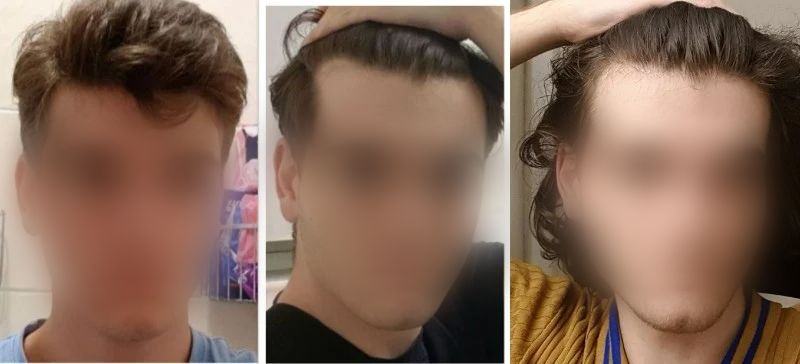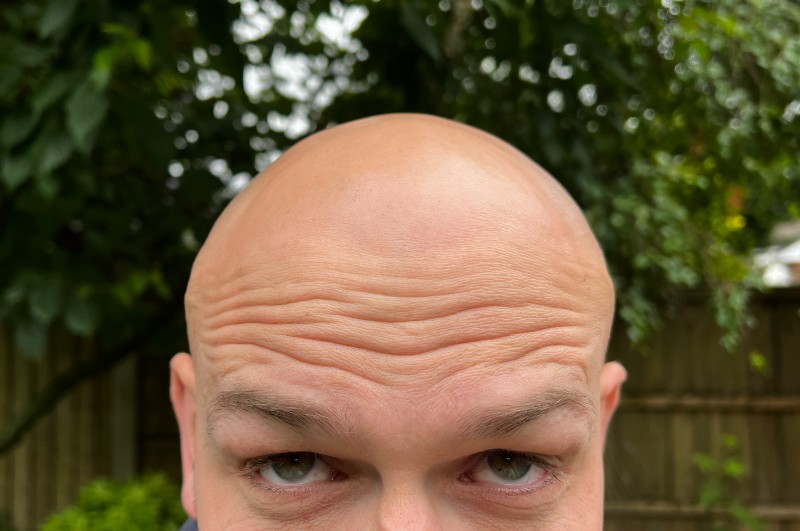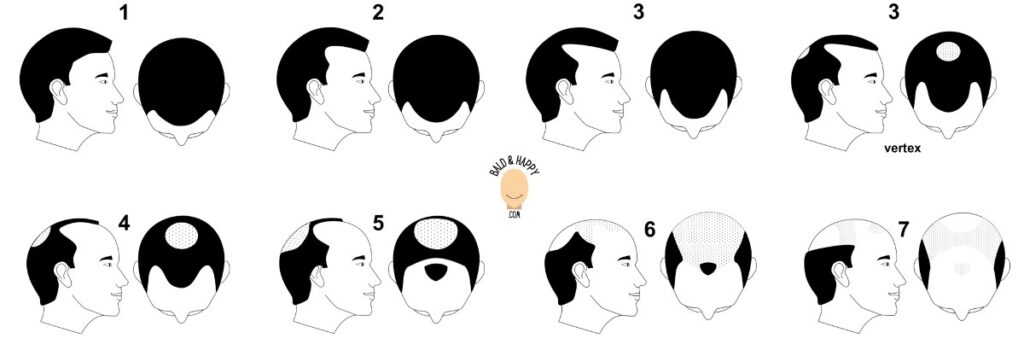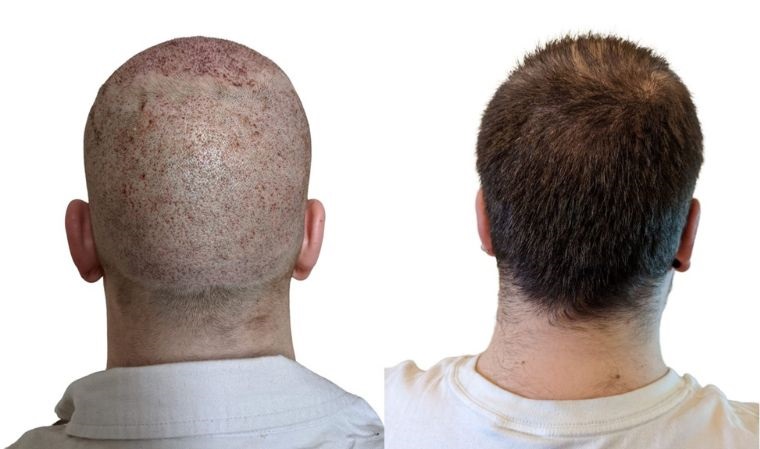If you’re worried about losing your hair, you may have researched stages of balding and come across the phrase ‘mature hairline’.
So what is a mature hairline, and how does it differ from a receding hairline?
What is a mature hairline?
A mature hairline is the natural movement of the hairline in young adults. Younger men and women have very solid hairlines with closed corners, but as men age, the hairline elevates and starts to thin at the temples.
Is a mature hairline a real thing?
Some people dismiss the idea of a ‘mature’ hairline as simply the first stage of balding. The theory is that anyone with a mature hairline is in denial about hair loss. However, a mature hairline is a very real thing that actually happens to everyone.
When the hairline moves back between half an inch to an inch from where it started, this is called a mature hairline. The process occurs with no thinning or miniaturization of the hair follicles. This is what separates a mature hairline from Male Pattern Baldness.
In this article, I’ll explain the difference between a mature hairline and a receding hairline. I’ll also answer questions about when a hairline matures, and what can be done if someone wants to fix it.
Mature hairline examples
Here are a couple of examples of mature hairlines:

The photo above shows a mature hairline that isn’t too much of a concern at the moment but could easily develop into a receding hairline. The hair at the temples has thinned and moved back, but this could easily stay this way for life.
The next example shows some initial recession, but the hairline has been monitored over time without any obvious signs of further hair loss:

Mature hairline vs receding – what’s the difference?
A mature hairline is similar to a receding hairline but there is a difference. If the hairline moves back beyond an initial elevation and there is thinning, this is a receding hairline. A mature hairline is where the overall thickness of the hair is normal but the hairline changes.
In terms of how high a hairline has to recede to be considered a true receding hairline, use the finger test. The middle of a mature hairline should only be the width of your index finger away from the top wrinkle in your forehead.
At the corners, expect your hair to recede a little more. As a guideline, expect 1.5 inches between the hairline and the top wrinkle.
If you want to consult a professional, there are more scientific ways to distinguish a mature hairline from a receding hairline. Microscopic evaluation can give an indication of whether someone is genuinely balding or whether they are simply developing a mature hairline.
Under a microscope, it’s possible to see significant miniaturization of hair follicles at the very front of the hairline (in the first 1-2 cm). This is an indication of active hair loss, but during the appearance of a mature hairline, a microscope won’t show any thinning or miniaturization.
Does a mature hairline mean I’m balding?
A mature hairline doesn’t necessarily mean you’ll go bald. If your hair is receding without visible thinning, there’s every chance your hair will stay exactly as it is. Where there is all-over miniaturization of hair follicles, Male Pattern Baldness is the cause.
Balding hair is where the miniaturization continues after the hairline recedes to the elevated stage, and thinning occurs across the whole top of the head.
The first sign of this is generally thinning of the frontal forelock and hair at the temples. The hair may be fine enough to see your scalp. This is caused by the effects of dihydrotestosterone (DHT) on hair follicles.

DHT is a hormone that is created in men when the testes process testosterone, which starts during puberty. DHT shrinks the hair follicles, causing hair to thin.
Men are affected by DHT to varying degrees, with some losing all their hair (like me) and others keeping the majority into their old age.
Whether DHT will cause you to lose your hair is dictated by the genes passed down from your parents. There are some myths to clear up here – hair loss isn’t only passed down from the mother’s side, and baldness doesn’t skip a generation!
If you start to see your hairline receding, that’s because your genes are allowing DHT to affect your hair follicles. There are several forms of DHT blockers available, some that have side effects.
At what age does a hairline mature?
Most men start to experience changes in their hairline after the age of 18-20. At this point, they notice a slight receding of the hair at the temples, and an elevation of the hairline in the middle of the forehead.
This is due to the hair being exposed to DHT for a number of years after puberty. By the time we reach our 40s, most of us will have either settled into a mature hairline. For some of us, the effects of DHT on our follicles will result in Male Pattern Baldness.
After the mature hairline has developed, hair loss may stop altogether, or it may continue. Different people experience different rates of hair loss, and you can’t predict how significant the hair loss will be.
Some men stop losing hair after the initial development of the mature hairline. Meanwhile, some continue to full baldness, as I did by the time I reached my late 20s.
Others may not lose any more hair until their 60s and even reach old age with a relatively full head of hair.
Does a mature hairline stop receding?
A mature hairline usually stops after half an inch to one inch of elevation away from the forehead. If Male Pattern Baldness causes the movement of the hairline, thinning will continue across the scalp. Otherwise, the hairline will settle in its ‘mature’ shape and position.
As mentioned above, the key difference here is whether a person’s hairline is truly receding. If they are merely developing a genuine mature hairline, it will stop receding.
However, if a receding hairline is being caused by miniaturization of the hair follicles, balding will continue. It’s not possible to know how far Male Pattern Baldness will develop, but a microscopic evaluation can give an estimate.
Can you fix a mature hairline?
Firstly, there’s no need to overthink a mature hairline. It happens to everyone, it’s perfectly natural and doesn’t look unusual or unattractive in any way.
However, if you want to do something about it for any reason, there are a number of options you can take to fix your mature hairline:
Try a buzz-cut
There’s no doubt that a buzz-cut or even a closely-cropped hairstyle makes hair loss less visible.
For Caucasian men with brown or black hair, the contrast between light skin and dark hair can make hair loss more noticeable.
The lighter the skin and the darker the hair, the more noticeable that contrast becomes. Therefore, by shaving the hair down to a #1, for example, there is less dark hair to contrast with the skin.
Go bald
If a shaved head still shows too much of a contrast, the natural next step is to shave your hair off completely.

This is less about hiding your hair loss and more about embracing it. For many people, shaving their head is a big decision, but they find new confidence once they shave it off.
That attitude is useful when it comes to dating, too. Having the self-confidence to face the world without hiding behind your hair is a really attractive trait in a man.
Plus, while there are people who won’t date a bald guy, I’ve met some women who are actually more attracted to bald men. For some, it’s practically a fetish!
If you’re still worried about braving the shave, here are a few useful things to know before you shave your head. If you’re not sure it’s for you, this might help: What would I look like with a bald head?
SMP
If baldness isn’t for you, scalp micropigmentation could be the best option to fix a mature hairline.

This is because SMP can work with all types of hairline and all levels of hair loss. If your hairline is genuinely just mature and you’re not suffering from Male Pattern Baldness, SMP can even work with slightly longer hairstyles to make the hair look thicker.
SMP can be painful, but not unbearable (depending on your tolerance). It’s not undetectable when looking up close, but at first glance, nobody will suspect that your hair has receded at all.
Hairpiece/hair system
It’s a shame there’s a stigma around wearing a hairpiece because they’ve come a long way since the unconvincing wigs that were around a few years ago.
These days, hairpieces aren’t just Hollywood props for famous actors. I spoke to Henry, who wore a hairpiece to help with his confidence when he started to lose his hair:
“People were advising me to shave it off but my reaction was ‘why should I have to?’ I had friends who went bald really young, but I didn’t want to commit to shaving.”
Henry looked into a hair system to keep his appearance relatively the same and was impressed with the result. He returned once a month to have the excess glue cleaned off and the hair system re-glued.
While his hair system looked great at first, the inevitable wear and tear started to show, and maintenance became a factor. The cost of the regular appointments started to add up and Henry eventually opted for a more permanent solution – a hair transplant.
Hair transplant
A hair transplant is generally only performed for a patient with ‘sufficient’ hair loss. Generally, the patient will be a Norwood stage 3 or above.

The transplant can be done as long as there is a large enough donor area, usually at the back of the head.

However, the procedure can also be used for smaller areas, such as in the correction of a mature or uneven hairline. However, this is unusual and it’s more common for hair transplants to correct baldness on the top of the head.
Is a Norwood 2 a mature hairline?
Norwood 2 is regarded as a mature hairline, as this is the first stage of recession after a full head of hair. Norwood 1 is full coverage with no thinning or receding at all, which is generally only seen in young people whose hairline has not yet matured.
The Norwood scale only measures coverage of the head, however, and not the cause of the movement of the hairline. This means there could be two reasons for someone reaching stage 2 on the Norwood scale.
Firstly, their hairline could be settling into a mature hairline following the initial effects of puberty. But if DHT production in the testes has affected the hair follicles enough that the hair is thinning, the person can expect further recession of the hairline.
Does everyone get a mature hairline?
Very few people are fortunate enough to keep the hairline they have in childhood. 96% of caucasian men will develop a mature hairline. So while it doesn’t quite happen to everyone, it is incredibly common, and nothing to worry about.
Here is the scientific research on the number of men who experience mature hairlines. As you can see, the exact statistics are only available for white men, who are also ‘four times more likely than black men to develop premature balding’.
Once the mature hairline has developed you can either see a doctor for a microscopic evaluation or simply wait and see what happens.
As for whether you’ll then go bald, that’s a numbers game. Two-thirds of all men in the US will experience some thinning or loss of hair by the time they hit 35. By the time we hit 50, there’s a massive 85% chance of “significantly thinning hair” according to the American Hair Loss Association.
So while not everyone develops a mature hairline, the chances are that the vast majority of us will experience hair loss of some description.
Summary
If you think you’re developing a ‘mature hairline’, my advice is not to worry about it.
As explained above, it’s something that almost all of us will experience. A mature hairline isn’t the same as a receding hairline, which is far less common.
If you do end up losing your hair, the worst thing you can do is ignore it, or live in denial. You have options including medication, scalp micropigmentation, or even a hair transplant.
If none of those are for you, then remember that bald looks a thousand times better than balding. Yes, hair loss is a stressful process and I wouldn’t pressure anyone into shaving their head before they’re ready, but it’s better to be bald and confident than balding in denial.
There are plenty of ways to make bald look good. But if you struggle to imagine feeling confident as a bald man, there are things you can do to help yourself.
Try to keep a healthy tan, grow a badass beard if you’re able, keep your wardrobe looking sharp, and hit the gym. There are very few bald people who don’t look instantly better with a tan, a beard, the right clothes, and a little more muscle.

To help you out, I wrote guides to pairing a shaved head with a beard and the latest fashion for bald men.
And of course, if you make these changes when you’ve developed a slightly-more-than-mature hairline, you’ll already look great if the time comes that you eventually go bald.

